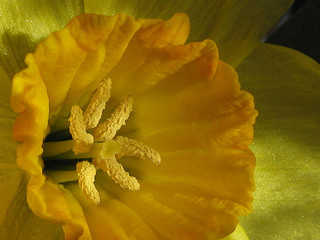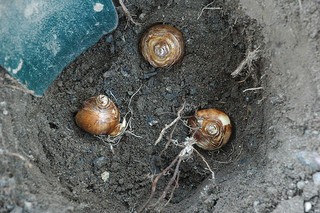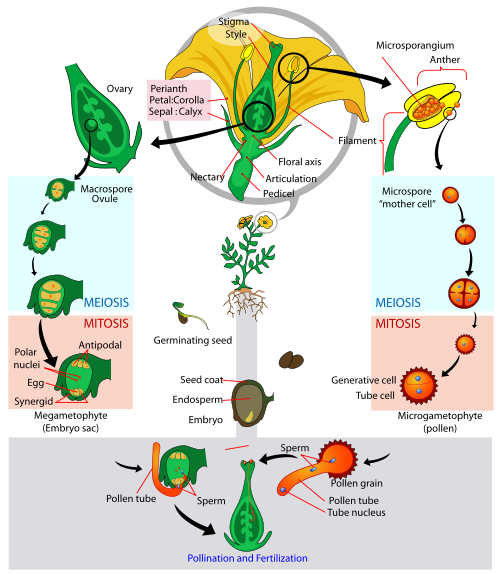Discovering Reproduction
There are two ways Narcissus
pseudonarcissus can reproduce: either by seed or by
producing bulbs. Different circumstances require either of these
different methods of reproduction for this plant.
First, the wild daffodil can reproduce by generating seeds, which is a sexual method of reproduction. The flowers must be fertilized by an outside source in order to create these seeds, and pollen is required for this process. There are two important parts to a typical plant that are necessary for this type of reproduction. The pistil contains the stigma and the female gamete, where the daffodil's ovule is found. On the stamen of a plant, pollen is produced, which contains the male gametes. When pollen is transported from one plant to another, it drops into the stigma and fertilizes the ovules of the plant, inside its ovary. A seed then develops from the fertilized ovule. When the daffodil blooms die, the tiny black seeds are dry and ready for dispersal. The seed pod (ovary) of the daffodil cracks open, and seeds either fall to the ground or are transported by wind or animals to a new location.
Essentially any insect or organism
can serve as a pollinator for the daffodil. It
really doesn't matter how the pollen gets in the
stigma, it just has to come in contact with it in
order to start fertilization. 
From seeds, daffodils take a very long time to grow into a full plant. It can take from five to seven years for a daffodil to bloom from a planted or dispersed seed. For this reason, daffodils generally do not reproduce from seeds. Instead, they rely on a more common, trusty way to pass on their genes. Bulbs help them reproduce much more quickly. These bulbs serve as important adaptations for the daffodil, which can be explored more on the adaptation page.
At the base of a daffodil is its bulb, from which roots extend into the ground. In order to create more daffodils, the bulb splits, forming smaller bulbs called bulblets. Another way for the daffodil to reproduce asexually while using its bulbs is for the plant to develop very tiny bulbs on its stem, called bulbils. These new bulbs can then be cut or peeled away from Narcissus pseudonarcissus, and planted. New wild daffodils will grow from the transplanted bulbs. Bulbs are a very common way for daffodil cultivators to grow these plants quickly and efficiently, instead of waiting several years for seed growth. Though these bulbs look like onions, they should not be eaten, due to their toxicity. To learn more about a daffodil's poison, visit the facts page.
The following diagram is the basic
reproduction of an angiosperm, displayed in an
easy-to-follow format. It specifically demonstrates
where meiosis and mitosis occur in the life cycle of
a plant like Narcissus pseudonarcissus.
Follow this link to revisit the homepage.
~ Discover more about how the wild daffodil interacts with other organisms. ~
